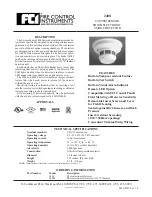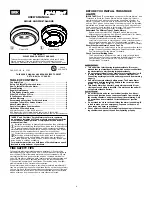
6
NookBox
Installation Guide
Smoke Mini Detector
ZigBee Network Setup
ZigBee Device Guideline
ZigBee is a wireless communication protocol that is reliable and has low power consumption and high transmission efficiency. Based on the
IEEE802.15.4 standard, ZigBee allows a large amount of devices to be included in a network and coordinated for data exchange and signal
transmission.
Due to the fundamental structure of ZigBee network, ZigBee device will actively seek and join network after powering on. Since performing a
task in connecting network may consume some power, it is required to follow the instructions to avoid draining battery of a ZigBee device.
• Ensure your ZigBee network router or coordinator is powered on before inserting battery into the ZigBee device.
• Ensure the ZigBee network router or coordinator is powered on and within range while a ZigBee device is in use.
• Do not remove a ZigBee device from the ZigBee network router or coordinator without removing the battery from a ZigBee device.
Joining the ZigBee Network
As a ZigBee device, the Smoke Detector needs to join a ZigBee network to transmit signal when smoke concentration or temperature
is detected. Please follow the steps bellow to join the Smoke Detector into ZigBee network.
The Smoke Detector has 3 ZigBee Endpoints for PIR, Smoke Detector and Temperature Sensor function. When joining ZigBee network,
it will be recognized as
3 separate ZigBee devices
and will occupy
3 zones
in your ZigBee network coordinator.
1. Insert the battery into the battery compartment to power on the Smoke Detector.
2. The Smoke Detector will emit 2 short beeps, and begin warm up for 1 minute, LED flashes every 2 seconds.
3. After 1-minute warm up period expires, the Smoke Detector will emit a beep to indicate it now enters calibration process.
The calibration process takes 1~7 minutes; the LED will continue to flash during calibration.
Joining ZigBee network is
prohibited
during warm up and calibration process. After calibration process the Smoke Detector will
emit a 2-tone beep, LED will turn off.
4.
The Smoke Detector is only available for joining the ZigBee network after completing calibration.
Press and hold the Test Button for 10 seconds and release to search for existing ZigBee network. Please make sure the permit-to-join
feature on the router or coordinator of your ZigBee network is enabled.
5. After joining the ZigBee network, the Smoke Detector will be registered in the network automatically. Please check the ZigBee
coordinator, security system control panel or CIE (Control and Indicating Equipment) to confirm if joining and registration is successful.
6. When calibration is complete, the Smoke Detector will emit 2 beeps and LED will stop flashing to indicate it is now under normal
operation. If calibration fails, the Smoke Detector will sound continuous beep.
7. Under normal operation, if the Smoke Detector loses connection to its current ZigBee network, the LED indicator will flash
every 20 minutes to indicate the situation. Please check your ZigBee network condition and Smoke Detector signal range to correct
the situation.
Removing Device from ZigBee Network (Factory Reset)
To remove the Smoke Detector from current ZigBee network, the Smoke Detector must be put to Factory Reset to complete device removal.
Factory Reset function will clear the device of its stored setting information and prompt the device to search for new ZigBee network.
Before removing device, make sure the Smoke Detector is within current ZigBee network signal range.
1. Press and hold the function button for 10 seconds, then release the button to reset Smoke Detector.
2. Upon reset, the device will clear current ZigBee network setting and transmit signal to ZigBee coordinator to remove itself from current
ZigBee network. It will then actively search for available ZigBee network again and join the network automatically.






























